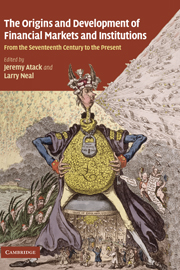 The Origins and Development of Financial Markets and Institutions
The Origins and Development of Financial Markets and Institutions Book contents
- Frontmatter
- Contents
- List of figures
- List of tables
- List of contributors
- Preface and acknowledgments
- 1 Financial innovations and crises: The view backwards from Northern Rock
- 2 An economic explanation of the early Bank of Amsterdam, debasement, bills of exchange and the emergence of the first central bank
- 3 With a view to hold: The emergence of institutional investors on the Amsterdam securities market during the seventeenth and eighteenth centuries
- 4 Was John Law's System a bubble? The Mississippi Bubble revisited
- 5 Sir George Caswall vs. the Duke of Portland: Financial contracts and litigation in the wake of the South Sea Bubble
- 6 The bell jar: Commercial interest rates between two revolutions, 1688–1789
- 7 Comparing the UK and US financial systems, 1790–1830
- 8 Natural experiments in financial reform in the nineteenth century: The Davis and Gallman analysis
- 9 Regulatory changes and the development of the US banking market, 1870–1914: A study of profit rates and risk in national banks
- 10 Anticipating the stock market crash of 1929: The view from the floor of the stock exchange
- 11 The development of “non-traditional” open market operations: Lessons from FDR's silver purchase program
- 12 The interwar shocks to US–Cuban trade relations: A view through sugar company stock price data
- 13 Central bank reaction functions during the inter-war gold standard: A view from the periphery
- 14 When do stock market booms occur? The macroeconomic and policy environments of twentieth century booms
- 15 Lessons from history for the twenty-first century
- Index
- References
13 - Central bank reaction functions during the inter-war gold standard: A view from the periphery
Published online by Cambridge University Press: 04 August 2010
- Frontmatter
- Contents
- List of figures
- List of tables
- List of contributors
- Preface and acknowledgments
- 1 Financial innovations and crises: The view backwards from Northern Rock
- 2 An economic explanation of the early Bank of Amsterdam, debasement, bills of exchange and the emergence of the first central bank
- 3 With a view to hold: The emergence of institutional investors on the Amsterdam securities market during the seventeenth and eighteenth centuries
- 4 Was John Law's System a bubble? The Mississippi Bubble revisited
- 5 Sir George Caswall vs. the Duke of Portland: Financial contracts and litigation in the wake of the South Sea Bubble
- 6 The bell jar: Commercial interest rates between two revolutions, 1688–1789
- 7 Comparing the UK and US financial systems, 1790–1830
- 8 Natural experiments in financial reform in the nineteenth century: The Davis and Gallman analysis
- 9 Regulatory changes and the development of the US banking market, 1870–1914: A study of profit rates and risk in national banks
- 10 Anticipating the stock market crash of 1929: The view from the floor of the stock exchange
- 11 The development of “non-traditional” open market operations: Lessons from FDR's silver purchase program
- 12 The interwar shocks to US–Cuban trade relations: A view through sugar company stock price data
- 13 Central bank reaction functions during the inter-war gold standard: A view from the periphery
- 14 When do stock market booms occur? The macroeconomic and policy environments of twentieth century booms
- 15 Lessons from history for the twenty-first century
- Index
- References
Summary
The years between the two World Wars were ones of economic turmoil and crisis. The inter-war gold standard, created as an attempt to rebuild the pre-1914 gold standard, lasted a mere six years from 1925–1931 and failed to generate economic growth and prosperity. Many scholars have attempted to explain the fragility of the inter-war gold standard, focusing on different aspects of the regime, such as structural problems within the system, gold imbalances, the lack of an international hegemonic power, persistent deflation, and the changing social and political structures in the inter-war years. One particular area of focus with regard to the operation of the system has also been the study of central banks within the system. Did they play by the rules of the game, supporting the international monetary regime with interest rate adjustment, or were their policies guided by domestic constraints and objectives?
This chapter sheds new light on the central bank reaction functions of four countries on the periphery, namely Austria, Czechoslovakia, Hungary, and Poland, by exploiting a natural experiment that was run throughout the inter-war years in eastern Central Europe. The four selected countries constitute an interesting mix of different institutions, as shown in Table 13.1. In Austria and Hungary the central banks were reconstituted under the auspices of the League of Nations to import credibility and establish stability following the hyperinflations of the early 1920s. Czechoslovakia and Poland in contrast, created monetary authorities without any external control.
- Type
- Chapter
- Information
- The Origins and Development of Financial Markets and InstitutionsFrom the Seventeenth Century to the Present, pp. 388 - 415Publisher: Cambridge University PressPrint publication year: 2009
References
- 4
- Cited by
